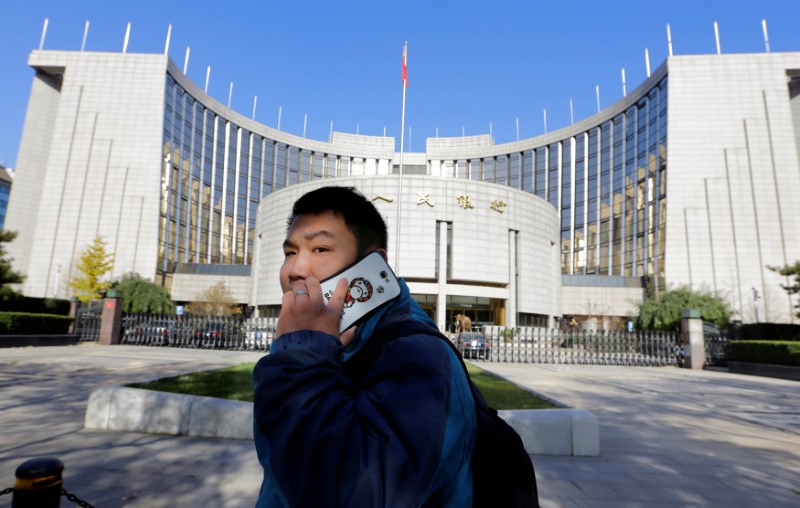 © Reuters. What China’s New, Powerful Financial Regulator Means for PBOC
© Reuters. What China’s New, Powerful Financial Regulator Means for PBOC
(Bloomberg) -- China’s sweeping changes to the financial regulatory system will see the central bank lose some of its functions to a new and enlarged oversight body, leaving it focused on broader economic and financial stability management.
The banking and insurance watchdog will be absorbed into a new bureau — a national financial regulatory administration — to oversee all financial sectors except the securities industry, according to a plan released at the National People’s Congress on Tuesday. Under the revamp, the People’s Bank of China will no longer have oversight of financial holding companies and financial consumer protection.
It’s a similar regulatory model used in Australia, which has three separate bodies overseeing the financial system. In fact, a PBOC adviser said in 2018 it was drawing on the experience of Australia as well as the UK as it shapes its regulatory framework.
Here are some of the key takeaways from the government overhaul and what it means for the central bank:
Modeling Australia’s system
Xing Zhaopeng, a senior China strategist at Australia & New Zealand Banking Corp., said the changes announced Tuesday would make China’s system most similar to Australia’s.
Under that model, the Reserve Bank of Australia is charged with conducting monetary policy, working to maintain a strong financial system and issuing the nation’s currency; the Australian Securities and Investments Commission is the nation’s corporate, markets and financial services regulator; while the Australian Prudential Regulation Authority supervises banks, insurers and the pensions industry.
What Bloomberg Economics Says...
These steps provide clear mandates and boundaries for the institutions regulating the financial sector. In this regard, the new structure removes regulatory gaps and overlaps.
David Qu, China economist
China has kept the China Securities Regulatory Commission, which overseas the securities and futures markets, as an individual entity. The new beefed up financial regulator will oversee micro-level market behavior and financial institutions and consumer rights, while the PBOC will be charged with managing macro-level or systemic risks and financial stability through the macroprudential mandate.
A more streamlined central bank
The PBOC will cut its county-level branches, which will be absorbed to city-level branches, according to Tuesday’s report. It will remove a clutch of branches that each oversees work in multiple provinces, and instead set up 31 provincial-level branches along with five separate branches in cities including Shenzhen.
Changes to the regional branches reverses a structuring plan set up in the late 1990s after the Asian Financial Crisis, according to Bruce Pang, chief economist for Greater China at Jones Lang LaSalle Inc. Some cross-provincial branches were created at the time in order to avoid conflicts with provincial level governments.
With governance of local authorities becoming more centralized, it means there’s less need for cross-provincial branches, as provincial-level branches can better facilitate the execution of policies, Pang said.
Greater focus on risk control
Duncan Wrigley, chief China economist at Pantheon Macroeconomics Ltd., said the regulatory reforms will “close opportunities for regulatory arbitrage,” such as online finance companies performing de facto banking functions like lending, with much lower capital requirements than banks.
Ant Group Co. is a case in point. Chinese regulators halted Ant’s would-be record initial public offering at the last minute in 2020 and rushed to issue new rules to regulate online lenders including Ant.
John Yasuda, a professor at Johns Hopkins University who specializes in regulatory governance in China, said there had been a “growing sense that the segmented regulatory system was allowing some financial products to fall between the stools.”
He said the Financial Stability and Development Committee — a regulatory body created under the State Council in 2017 and led by Vice Premier Liu He — was designed to play a coordinating role in regulating the financial system. However, the changes suggest “the forces of consolidation are now gaining the upper hand,” he said.
Some things remain the same
The PBOC remains under the State Council, China’s cabinet. Its goals — according to law — is to set and implement monetary policy as well as prevent financial risks under the leadership of the State Council.
Unlike independent peers in most developed economies, the PBOC needs the State Council’s approval on major policy steps, such as adjustments to interest rates and money supply. While there’s some scope to manage liquidity at its discretion, Federal Reserve or RBA-style independence remains a distant proposition.
The regulatory revamp “will make the PBOC more focused on implementing monetary policy, and thus closer to international norms,” said Wrigley “But it is under State Council leadership, and in that respect very different from the independent central banks in most advanced economies.”

